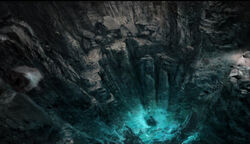
Gaia.
All life is born of Gaia and each life has a spirit. Each new spirit is housed in a physical body. Through their experiences on Earth each spirit matures and grows. When the physical body dies the mature spirit, enriched by its life on Earth, returns to Gaia, bringing with it the experiences, enabling Gaia to live and grow.
Dr. Sid's Diary.
The Gaia Theory (ガイア理論, Gaia Riron?) is a scientific theory originating from the school of Bio-Etherics in the movie Final Fantasy: The Spirits Within.
The theory posits that, as each biological being has a biotic spirit, or "life force", so too does the planet. Each life form's spirit is said to be born of this planet-sized spirit (or "Gaia") and each life returns to Gaia upon death to be born again. Through each cycle, each spirit brings the experiences of its life back to Gaia upon death, enabling Gaia to live and grow.
Gallery[]
Etymology[]
Gaia or Gaea was the goddess or personification of Earth in ancient Greek religion, one of the Greek primordial deities. Gaia was the mother of all: the heavenly gods, the Titans and the Giants were born from her union with Uranus (the sky), while the sea-gods were born from her union with Pontus (the sea). The Greek word "γαῖα" (transliterated as gaia or gaea) is a collateral form of "γῆ" meaning Earth. Her equivalent in the Roman pantheon was named Gaea (Terra in more ancient documents). This is alluded to in Final Fantasy IX with the existence of Gaia's twin world.
The mythological name Gaia was revived in 1979 by James Lovelock, whose Gaia hypothesis proposes that living organisms and inorganic material are part of a dynamic system that shapes the Earth's biosphere, and maintains the Earth as a fit environment for life. In some Gaia theory approaches the Earth itself is viewed as an organism with self-regulatory functions. This theory is especially alluded to in the Final Fantasy: The Spirits Within take on Gaia as the planet's soul.
The real-world "Gaia Theory" is known as the "Gaia hypothesis", introduced by Dr. James Lovelock in the 1960s.


